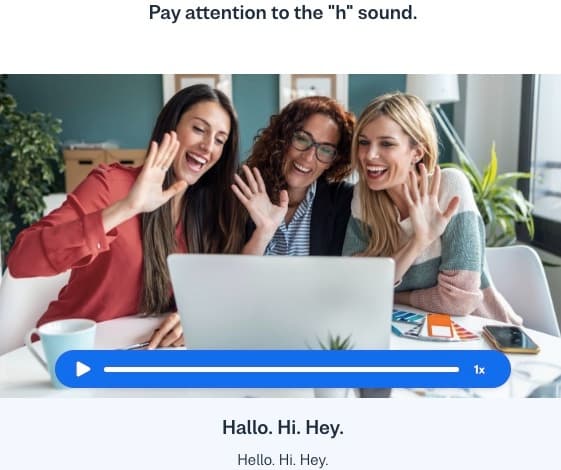I want to learn...
Intimidated by the German alphabet? You might be tempted to skip it altogether and jump ahead to handy phrases, but taking the time to learn the basic German sounds will take you farther than you think.
The good news is that you already know more than you realize. German has all the same letters as English, plus a few more thrown in for fun. Once you can recognize the letters that might trip you up, you’ll be ready to test your skills!
How many German letters are there in the German alphabet?
If you’re wondering about this question, you’re not alone! Even the experts can’t make up their minds, with some saying 26 while others say 30.
While many say that the German alphabet has 26 German letters just like English, there are also four additional letters in the German language: ä, ö, ü and ß. If you count these, this brings the count up to 30 letters.
The main thing to remember is that if you know English, you already have 26 letters under your belt. Once you’ve given some attention to the extra vowels, it’s a matter of learning the letters that look the same as English but sound different.
Thankfully the German language is very orderly – much like German society. Unlike English, it follows consistent phonetic rules and you can sound out the word according to the alphabet and get the right pronunciation in most situations.
German alphabet
| Letter | Name (Pronounciation) | Example |
|---|---|---|
| A | A (ah) | Apfel (apple) |
| B | Be (bay) | Bein (leg) |
| C | Ce (tsay) | CD (CD) |
| D | De (day) | Donnerstag (Thursday) |
| E | E (ay) | Elefant (elephant) |
| F | Ef (eff) | Ferien (vacation) |
| G | Ge (gay) | gehen (to go) |
| H | Ha (hah) | Haus (house) |
| I | I (eeh) | Ich (I) |
| J | Jott or Je (yot) | Jahr (year) |
| K | Ka (kah) | Kinder (children) |
| L | El (ell) | lieben (to love) |
| M | Em (em) | Mittwoch (Wednesday) |
| N | En (en) | neu (new) |
| O | O (oh) | Ohr (ear) |
| P | Pe (pay) | Papier (paper) |
| Q | Qu or Que (koo) | qualität (quality) |
| R | Er (err) | rot (red) |
| S | Es (es) | Sonne (sun) |
| T | Te (tay) | Tag (day) |
| U | U (ooh) | Uhr (clock) |
| V | Vau (fow) | Vater (father) |
| W | We (vay) | Woche (week) |
| X | Ix (iks) | Xylofon (xylophone) |
| Y | Ypsilon (oopsilohn) | typisch (typical) |
| Z | Zett (tset) | Zeit (time) |
| Ä | Ä (eh) | Mädchen (girl) |
| Ü | Ü (uuh) | früh (early) |
| Ö | Ö (ouh) | möchten (to want) |
| ẞ | Eszett (ess-set) | Straẞe (street) |

It’s good to know that when referring to a German letter, you use the article das in front of it. German has three article forms: der (masculine), die (feminine), and das (neuter), but when talking about letters we always stick with das. For example:Das A, das B, das C, das deutsche Alphabet.
What are the four extra letters in German?
Vowels with Umlauts: Ä, Ö, and Ü
Don’t let the extra vowels in German scare you away! These three letters are created by adding what’s called an umlaut – two dots – to the top of the vowels. The umlaut just means that the letter has its own sound, and is not pronounced the same as the normal vowel without the umlaut. While ä, ö, and ü are sounds we don’t typically use in the English language, your mouth can learn these sounds with just ein bisschen (a little) effort.
Ä is the umlaut vowel with the closest sound equivalent in English. Ä sounds like the short “eh” sound in the English word “head”. The sound can be elongated in some words, but make sure it does not slide into an “ay” sound.
The Ö and Ü vowels are more challenging because their sounds don’t exist in the English language. For Ö, start by forming the word “look” in your mouth, then purse your lips into an “O” shape. To create the Ü sound, start to make an “eww” sound as if something is disgusting, and then purse your lips like you are going to whistle. Don’t be afraid to look silly or exaggerate the sound!
If you don’t have a German keyboard, don’t panic – all umlaut vowels can be replaced with typing an E after the vowel instead. You can type schoen instead of schön (beautiful) and German-speakers will know exactly what you mean.
The Eszett: ß
Ever heard of a ligature? No, it’s not a medical term – a ligature is when two sounds or letters are put together to make a new letter. The German letter ß is a ligature and is also called a “scharfes s” (sharp s). But it’s simpler than it sounds–it actually just means “ss”.
The best thing about this letter? It sounds exactly like the “s” sound in English!
When you’re typing it’s also completely acceptable to replace the ß with “ss”, so that Straße becomes Strasse. In fact, Switzerland and Liechtenstein have completely done away with the ß and only use “ss”. If you’re up for a challenge, it’s also über cool to try writing the ß by hand!
German alphabet pronunciation: Challenging letters for English-speakers
Ready for some tips and tricks on German alphabet pronunciation?
R is one of the most difficult German letters for English-speakers to get right. The main thing to remember is that you need to soften your R sound in German, by moving it farther back in your throat.
If R is at the beginning of a word like Rad (wheel) then it has a stronger sound and can be rolled (some German dialects roll their R’s more, so you may hear various versions in different places!). If R is at the end of a word then it becomes even softer– almost inaudible– turning into an “uh” sound. Just like Mutter (mother) and Butter – R’s are soft!
Another example of a consonant taking a softer ending is when G comes at the end of a word. If you’re trying out the greeting Guten Tag, then the G at the end ofTag becomes like a soft “k” sound, sounding a bit like “tahk”.
J, V, and W easily fool English-speakers because they are pronounced like different letters in English. Here’s a cheat sheet for pronunciation: J = English Y sound –Jogging sounds like “yogging” V = English F sound –Vielen Dank (thanks so much) sounds like “Feel-en Dank” W = English V sound –Weg (way) sounds like “vegg”
While the alphabet pronunciation for C is tsay, most words that start with Care pronounced with a hard “k” sound. That’s because they are words from other languages like Cafeteria and Computer. When you notice C at the beginning of a word, you can trust your instincts on how to say it!
Did you know there’s a Greek letter in the German alphabet? Ypsilon (Y) originates from Greek but is actually rare to come across in German. It’s usually found in foreign words and is pronounced like the “ou” sound in “you”.
Now you know your A to ß
Now you’ve added four new letters to your alphabet toolbelt and navigated potential pronunciation stumbling blocks. You’re ready to get out and practice!
Viel Spaß! Have fun!
Newlanguages


